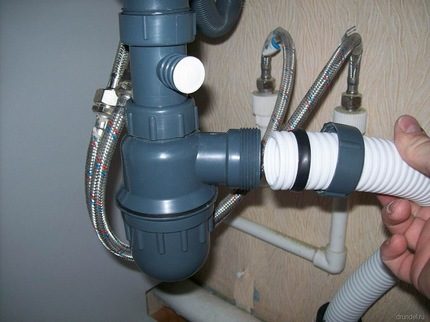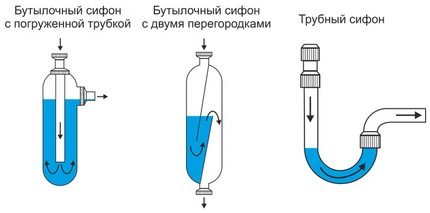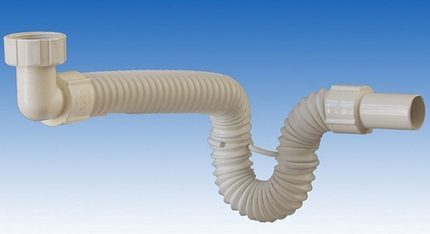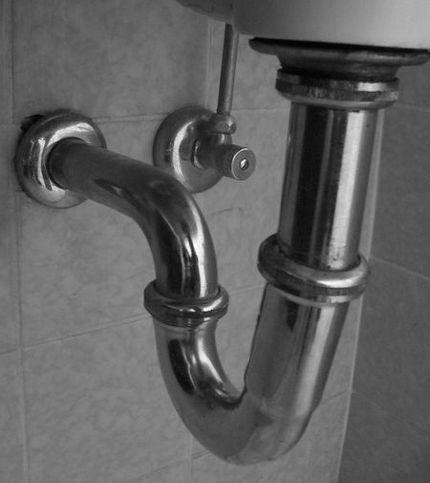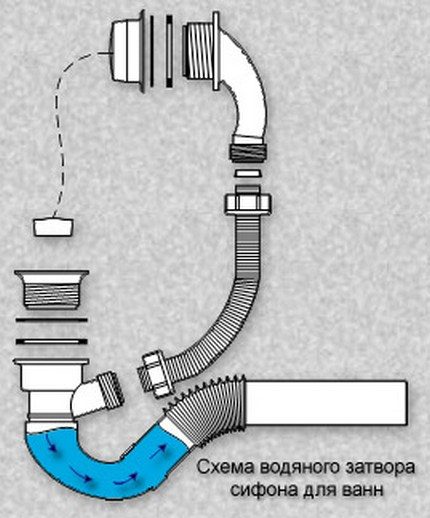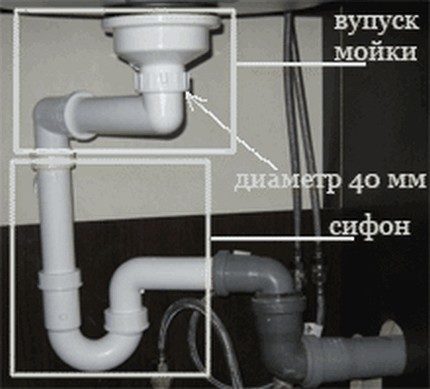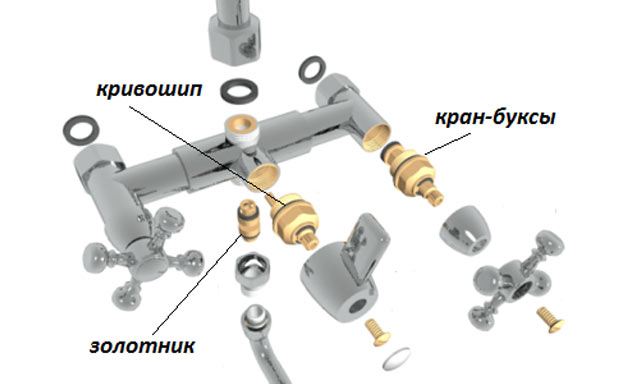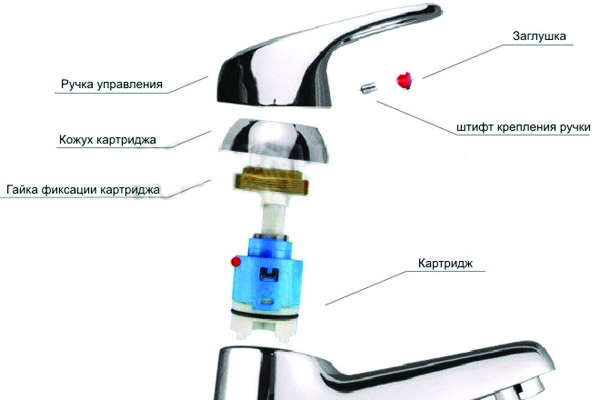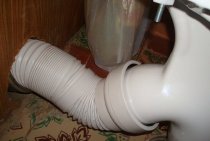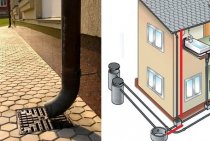General information
A siphon is a bent pipe, which is located under the sink. This design can be seen in every kitchen. This raises the question - why is it needed, what function does it perform?
Firstly, through this knee, sewage entered the sewer. And secondly, a water seal prevents unpleasant odors from the sewer. If you remove it, then in an hour the room will be filled with a specific unpleasant smell.
Types of siphons
As mentioned above, the sink siphon device can vary greatly depending on its type.
Structures are of the following types:
- Pipe - is a pipe bent by an elbow. Most often they are found in Soviet times, when the drain was made of cast-iron pipes. This design takes up a lot of space, besides, it can only be cleaned of large debris.
- Siphon-corrugation - resembles the previous design, but the pipe in this case is soft, with folds. The zigzag bend is fixed with a plastic clamp. Its difference from other types is mobility, which allows you to move the sink over short distances. As a rule, the price for such a product is lower than for other types of structures, however, corrugated is not the most practical type. The disadvantage of this design is the relief surface, which quickly becomes clogged with fat. Therefore, such a product is not the most practical.
The bottle-shaped design got its name from the shape that resembles a bottle. Today, this is the most common type of elbow for a sink. The product has a flask that performs the function of a sump. If you accidentally drop a chain or other object into the drain hole, you can easily get it by unscrewing the sump cover. As a rule, the pouring pipe is located inside the flask, due to which a water seal is formed. This design, if necessary, is easy to unwind and clean.
In the photo - specialized siphons
In addition to the designs described above, there are other, specialized products that are much less common. For example, if the sink has two bowls, then a double design is used.
There are also siphons with a drain pipe for connecting a washing machine. There are also designs with an auto-drain and an overflow hole, which allow you to draw water into the sink and, if necessary, drain it by pressing one button.
Types of drain devices under the sink
According to the principle of the device
Drain systems for sinks are divided into two types:
- Bottle. In bottle-type siphons, the water seal is equipped with cylinders immersed in each other. A sump is equipped in the cavity of the siphon flask. Moving down in the middle of the inner pipe, the drains fall to the bottom of the siphon and then, rising through the slots of the inner and outer cylinder, enter the sewer.
- Pipe. Drain systems of the pipe version are double-turn structures in which the hydraulic barrier is equipped with a pipe elbow. The pipe bend can be made in the form of "S" or "U".
Bottle-type siphons got their name because of the shape that looks like a bottle. Easy-to-install and easy-to-use bottle devices are most in demand among consumers today.
Due to the fact that the outlet from the siphon is located approximately in the middle of the flask, the water seal in the system does not dry out for a long time. If it is necessary to connect several drains, the siphon can be equipped with an additional element.
Bottle-type designs are also good because they can include additional pipes for connecting a washing machine
Pipe drain devices are rarely used today.A modernized version of double-turn devices is a design equipped with a corrugated plastic pipe.
The softness and flexibility of the material allows you to give the pipe a curved shape, fixing it in the desired position.
Mixed devices are also on sale.
Mixed-type designs combine bottle-type structural elements and corrugated hose, which is included in the pipe system
The corrugated siphon used in the arrangement of mixed-type drain systems is a type of curved pipe. The only difference is that the part with the bend is made in the form of a movable hose, and not a solid pipe.
There are also siphon options designed for non-standard sinks. So, to connect the drain system under the washbasin, equipped with two bowls, you can purchase a double siphon, which will have two outlets.
Separately, it is worth highlighting the siphons of hidden installation. Although they cost an order of magnitude more expensive than the models described above, they are ideal for connecting sinks installed on open shelves.
Drain systems of structures of this type are hidden behind a decorative screen in a small niche.
Corrugations with nozzles D32, D40 and D50 mm are on sale, but you can also find universal products with a stepped end of the spout that fit any size.
Universal corrugations with branch pipes are equipped with cap plastic cuffs. But it should be borne in mind that transition cuffs will not guarantee such reliability as the same pipes of the calculated diameter.
According to the material of manufacture
The material for the manufacture of an overflow drain for a sink can be metal alloys or polymeric materials. The main advantage of plastic is its low cost and resistance to corrosion.
The service life of PVC products is relatively short. And besides, they do not differ in high sealing properties. For this reason, all docking elements are equipped with rubber gaskets.
In some European countries, products made of PVC material are prohibited for domestic use.
When creating polymers, leading manufacturers of sanitary equipment include a component in their composition that prevents bacteria from settling and growing on the surface of the plastic.
Due to this, the inner walls of PVC products, even during long-term operation, are not covered with mucus and a layer of dirt.
If you choose among metal products, then models made of bronze or brass are the most popular. They are stronger and more durable, but, unlike plastic, they oxidize over time.
On-site installation of metal structures can be difficult if it is necessary to shorten the outlet pipe.
This can be done only if you have the appropriate tool and possess the skills to handle them.
The inner walls of metal drains can accumulate dirt, which often leads to the formation of blockages and plugs.
To prevent the accumulation of dirt on the inner walls and the formation of blockages, choose metal products coated with a protective chromium film.
Assembly and installation of a siphon in the bathroom and in the kitchen instructions and diagrams
Installing a siphon with your own hands is an operation so simple that it makes no sense to invite a master plumber for it. Siphons of modern design are designed for assembly by hand, only in some cases a screwdriver may be needed. A miniature LED flashlight is also useful for illuminating hard-to-see places.
However, the work of installing a siphon is dangerous, and for good reason: you will have to clean the sewer pipe and keep it open for a while. And so that in the future the siphon does not become a source of trouble, you need to use high-quality materials and strictly follow the instructions for installing the siphon.
Purpose and design of the drain
The sink drain is a curved design, the main elements of which are the siphon and the drain pipe.
When flushing, water through the drain hole first enters the siphon and, moving along the curved “knee”, descends into the common drain
The outer element of the drain hole is a metal grill that protects the pipe from hair and small debris.
Located just below the drain hole, the siphon performs two key functions:
- Protects the drain pipe from clogging with waste penetrating through the hole in the sink.
- Interferes with distribution of the unpleasant smell coming from a sewer pipe.
The main secret of the siphon is in its bend.
Thanks to this constructive solution, the water does not completely leave the pipe, forming a kind of water seal, which prevents the spread of sewer "aromas" in the room.
Plastic model with one drain hole with a pipe diameter of 32 mm - the simplest version of the sink siphon
The device package includes the following items:
- frame;
- exhaust pipe;
- rubber and plastic cuffs;
- decorative overlay on the hole;
- rubber stoppers;
- nuts and screws.
In case of clogging of the system, this siphon can be easily removed and cleaned mechanically, chemically or by means of the pressure of a directed jet stream. To prevent such situations, manufacturers recommend purchasing sink drains equipped with overflow.
The design of the system differs in that it is equipped with an additional tube made of flexible corrugation or hard plastic. It connects the hole in the top side of the sink rim to the part of the drain system that is located in front of the trap.
Such a zigzag tube is fixed in the desired position with a plastic clamp.
Use of household chemicals
Many housewives, when a smell appears from the sink, begin to actively look for a remedy that, when poured into the pipeline, will eliminate the trouble. All compounds that serve to clean pipes can be divided into 2 groups:
- Industrial;
- Household.

The first are those produced by the chemical industry. These products are being developed by chemical scientists to get rid of organic pipe blockages. The most famous representatives of this group are the following brands:
- "Mole";
- "Rowdy";
- "Odorgon";
- "Domestos" and others.
Household means are called improvised compositions, which are most often present in every home. Kitchen sink odor can be eliminated with mustard powder, table salt, soda ash, or baking soda diluted with vinegar. All these funds are poured into the sink and filled with water, after which they do not use pipes for some time.
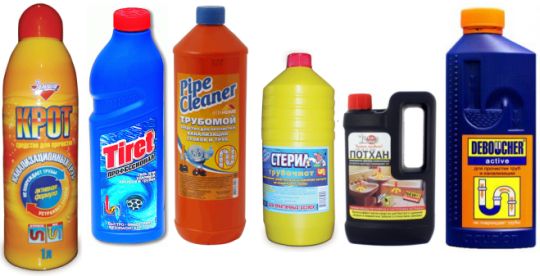
It should be noted that pollution of inorganic origin by means of household chemicals is not eliminated. It's just a transfer of money and time. This fact is not mentioned either in TV commercials or in the instructions for the drugs themselves.
Mounting dimensions
The connecting dimensions of the sewer couples are 32, 40 and 50 mm. Before buying a siphon, you need to measure the diameter of the old spout, and it is advisable to take a new one with the same fit. If there is no suitable siphon of the right size, you will have to buy a transition cuff. Also on sale are siphons with a stepped end of the spout, for all three sizes. The excess is cut off, and the bottom seal is purchased separately.
The sealing cuff in the last two cases must be purchased immediately, while the siphon is in hand, and immediately check how it sits on the spout, how elastic and durable it is. A siphon with large burrs on the edge of the spout, which does not allow the cuff to be planted, should not be taken: this indicates a low quality of plastic.The manufacturer is most likely "alternative" and stamps general purpose PVC plumbing.
Precautionary measures
Fecal water and sludge is a highly toxic and chemically aggressive substance; sewer gases are also explosive. The danger is aggravated by the fact that toxic substances can enter the body through intact skin.
Plumbers-trunkers are well aware of this and safety precautions are by no means neglected.
Home plumbers rarely have to deal with large masses of toxic substances or gas emissions from a pipe, but in each such case the consequences are severe precisely because of the neglect of precautions.
Residents of apartments have nothing to fear: a water lock in the siphon elbow securely locks the pipe outlet. But when replacing the siphon, its branch pipe will be open, and you will have to work with your hands in the immediate vicinity of the sludge and clean it off. Therefore, stock up on latex gloves, a plastic apron and a petal respirator. If all of a sudden that 1 out of 10,000 cases falls to your lot, it will do without harm.
Siphon material
Drain traps are mainly made of chrome-plated brass, PVC or propylene (polyisopropylene). Brass - the most expensive, their use can only be justified in terms of aesthetics and prestige. In all other respects, they are inferior to plastic ones in all respects, including durability: in the event of an accidental impact, the plastic siphon will win back or wrinkle, and the brass one may break or twist out of the pipe.
PVC is the cheapest and has the least hydraulic resistance. But with regular draining of hot water, a PVC siphon lasts 5-7 years. A propylene siphon is 5-20% more expensive than similar PVC, but if properly installed, it will last for decades. Hydraulic resistance for the siphon does not play a big role, and durable and chemically resistant propylene can be repeatedly cleaned with a hook or cable, and the miasma from the pipe will not corrode it. Propylene is especially good for an acrylic bath: their coefficients of thermal expansion are almost equal.
When buying a plastic siphon, be sure to check its completeness and quality:
- Outlet pipe. The threaded insert must be metal.
- Rubber gasket outlet pipe (spout).
- Two plastic nuts with a diameter of 32/40/50 mm.
- Conical rubber cuff with a diameter of 32/40/50 mm.
- Mounting sleeve with soft plastic skirt Ø 32/40/50 mm.
- Stainless steel clamping screw. Brass, even chrome, will turn green, and simple steel will rust with any coating.
- Decorative overlay plum. Also stainless steel.
- Drain gasket. Material - oil and heat resistant rubber (white) or silicone plastic. The polyethylene gasket is rejected without hesitation.
- Siphon body (bottle or knee).
- Bottom siphon plug with rubber O-ring. For bottle siphon only.
- Rubber drain plug.
Drain pipe
Drain pipes are used rigid or corrugated. It is easier to work with a corrugated pipe, especially under the bathroom, but the corrugation is not suitable for a kitchen sink: sludge intensively accumulates in the internal hollows of the corrugation (the drain from the kitchen is the dirtiest) and the corrugation inside the kitchen cabinet next to a bucket or other objects is easier to damage.
When installing a siphon, you will need a plastic or semi-liquid sealant. The best in properties and inexpensive - silicone. You just need to make sure that it does not turn out to be acidic. The test for chemical neutrality is very simple: squeeze a little and smell it. If it carries vinegar, it's not good, it's acidic. A sealant suitable for plumbing should either be completely odorless, or the smell should be weak and not sharp.
Occasionally, a sealant based on natural rubber (Germeplast, etc.) is found on sale. It looks like a grayish or yellowish sticky plasticine.It is very expensive, but only the estimated service life speaks of quality: 70 years. If necessary, the connection can be depressurized and the sealant can be reused.
Materials for the manufacture of kitchen faucets
In the manufacture of kitchen plumbing, the following materials are used:
- metal alloys.
- Polymers.
- Ceramics.
Each individual option has its own features and advantages:
- Metal faucets are the most popular and common. They do not oxidize or corrode. They are also resistant to chemical reactions. Modern models delight consumers with a long service life, aesthetics, and ease of use.
- Products made of polymers are distinguished by the most affordable cost. They do not have such a long service life as metal plumbing, but please with an attractive appearance and comfort.
- Ceramic products have stood the test of time. This material is not afraid of sudden changes in temperature, corrosion, abrasive substances.
The faucet in the kitchen is leaking how to fix it yourself
To repair a plumbing fixture in the kitchen yourself, prepare the following tools and materials:
- Knife with a sharp tip.
- Adjustable and hex wrench.
- Screwdrivers.
- Consumables: new cartridges, rubber gaskets, faucets - bushings.
- Technical aerosol WD 40, if the metal elements are stuck to each other.
It doesn't matter what type of faucet is installed in your kitchen. Its repair should begin with shutting off the water supply and draining its residues into the sink.
Next, we proceed to the repair, according to the design features of the plumbing device.
Single lever kitchen faucet repair
Single-lever taps fail due to:
- Cracks and chips formed on the body.
- Clogged cartridges.
- Wear of gaskets.
- Clogged aerators.
Dealing with these breakdowns is quite easy. If the leak appeared for other reasons, it is necessary to act in a certain sequence - slowly and carefully:
- Remove the decorative cap from the faucet body using a screwdriver or a sharp knife.
- In the resulting hole we will see a screw that connects the adjusting rod and the lever.
- Unscrew it with a hex wrench.
- We remove the lever from the body and unscrew the decorative casing. If the parts are not stuck to each other, you can do it by hand. Otherwise, we use the WD 40 prepared in advance.
- Under the decorative cover is a clamping nut. Carefully unscrew it with a wrench.
- If the ball device is disassembled, then there will be a sealing collar under the nut. It will need to be carefully examined for defects, breaks and the degree of contamination. We take out the ball and inspect its surface. It must be clean and even. Next, remove the supporting springs and seals. If they are in poor condition, then this leads to a leak.
- When disassembling the mixer with a cartridge, it is removed and subjected to a thorough inspection.
- Defective parts are replaced with new ones.
- We assemble the crane in the reverse order.
Attention: when carrying out repair work, the nuts are not tightened too tightly, as this will lead to deformation of the seals and disruption of the correct operation of the device. https://www.youtube.com/embed/uzZ_QSNs8E8
Repair of a two-valve mixer
If a two-valve faucet is installed in the kitchen, the principle of repair work is as follows:
- Remove the decorative cap on the flywheel in the valve.
- Unscrew the screw that secures the flywheel with a screwdriver.
- We remove the flywheel. In front of us there will be a crane - axle box.
- We unscrew it counterclockwise and inspect for defects.
- If the gasket of the worm-type axle box is damaged, we replace it with a new one. If you have a faucet with a bushing with ceramic discs, they change completely.
- We assemble the product in the reverse order.
Eliminating the causes of a leaking plumbing fixture on your own is quite easy and simple. But a mixer leak is not the only problem with its malfunction.
Other faucet breakdowns and troubleshooting
In almost all cities and towns, the quality of tap water leaves much to be desired. Because of this, contaminants appear on the aerator over time. When there is too much scale on the inside of the aerator, the water pressure decreases. Solving the problem is quite easy - replacing the aerator. It is quite easily unscrewed with an adjustable wrench or by tapping a hammer on the surface.
If the faucet is leaking due to a crack formed in it, only a complete change of plumbing will help. Silicone sealant can stop the leak for a short time.
To prolong the life of the faucet in the kitchen, it is recommended to use water filters, use the appliances carefully, do not tighten the valves too much and constantly monitor the condition of the plumbing.
You can fix the leaking plumbing in the kitchen in a timely manner with your own hands. To do this, you will need to prepare consumables and the necessary tools, carefully read the sequence of work and stock up on free time.
Possible plumbing defects
If there is no effect when cleaning the pipes in the sink in the kitchen and the sewer smell continues to come from there, the owners should think about mechanical damage to the pipeline. All pipe joints are carefully studied, because from illiterate installation blockages are quite possible.
The sounds made by water when directed into the drain can provide comprehensive information about the performance of the entire sewer system. If you hear a rustling of unknown origin or a strange gurgle, then the water seal is most likely broken. In the normal state, the water seal is designed to serve as a barrier between sewer "aromas" and the air of residential premises.
The siphon keeps odors out of the kitchen
In addition to a malfunctioning water seal, the causes of an unpleasant sewer smell from your sink can be the following phenomena:
- Vacuum air lock in the riser;
- Too long pipes;
- Eyeliners located under sharp slopes;
- Poor ventilation on the sewer system;
- Too small diameter of the riser pipe;
- Incorrectly installed siphon or corrugated pipe;
- Other reasons.
Infrequent use of the sink can also cause odors to come out of the sink. This becomes possible due to the evaporation of water from the water seal. Engine oil can be a way out of the situation.
If you are planning a long absence from home (business trip, vacation, etc.), you need to pour a few tablespoons of oil into the water seal. The evaporation rate of engine oil molecules is incomparably lower than that of plain water. There will be no smell from the sink when you return home. Sometimes the way out of the situation is to replace the gaskets on the pipes, to audit the performance of the siphon on the drain.
Features of the device of the main types of kitchen faucets
Bathrooms are predominantly fitted with thermostatic or touchless faucets. And in kitchens, it is customary to use simpler plumbing fixtures - two-valve or single-lever. All of them have the same elements: body, spout, aerator and gaskets. Otherwise, these devices are very different from each other.
The device of two-valve cranes
Two-valve mixers are the most common. To open or close the water, just turn the valve. These products have two separate taps combined in one body and one spout. You can turn on hot or cold water independently of each other.Their main drawback is adjusting the position of the flywheels to obtain water of the required temperature. The design of a two-valve device consists of the following elements:
- valve heads.
- valves.
- Corps.
- Outflow.
- Aerator.
The faucet body is installed in the hole made in the kitchen sink and connected with a sealing gasket for high-quality sealing. The device of the mixer directly depends on the type of locking elements used. There are currently only two options available:
- Ground-in ceramic discs that rotate within a segment limited from each other.
- Valve heads that perform rotational-translational movements or reciprocating.
Depending on the structure of the device, the convenience of its operation also depends. Such designs fail due to leaky rubber seals. You can solve this problem on your own.
The device and types of single-lever cranes
Single lever mixers are more modern. In them, the mixing of cold and hot water takes place in a hollow ball with three holes. Two of them are inlet for cold and hot water, and one is outlet for supplying water of a given temperature to the sink.
The advantages of single-lever plumbing include:
- Simplicity and convenience in operation.
- Adjustment speed for the required water temperature.
The single-lever crane consists of the following elements:
- Corps.
- Lever - switch.
- Outflow.
- Cartridge or ball lock.
- Aerator.
